-
 Thin iron tsuba of round form with design of family crests (mon) and arabesque (karakusa) in brass or copper inlay (suemon-zōgan) and occasional scattered brass dots or nail heads in ten-zōgan. Seppa-dai outlined with brass wire in the shape of a rope; kozuka-hitsu-ana outlined with scalloped brass wire. Rounded rim with iron bones (tekkotsu). The surface covered with lacquer (urushi). Ōnin school. Late Muromachi period, 16th century. Family crests on the face: 1:30: Two lines (double stripe) encircled (maruni futatsu biki). 4:30: Stylized clove (choji). 7:30: Divided rhombus, or four lozenges incorporated in one (wari-bishi); it is also called Takeda-bishi, the family crest of warrior Takeda Shingen (among the others). 10:00: Stylized Genji-mon (Genji kō-zu) or incense symbol. On the reverse: 2:00 - "Chinese cloud" not a crest. 5:00: Bit (Kutsuwa) 7:30: Number four in a fan (ōgi-san) 10:30: Two dots in a well frame (igeta).
Thin iron tsuba of round form with design of family crests (mon) and arabesque (karakusa) in brass or copper inlay (suemon-zōgan) and occasional scattered brass dots or nail heads in ten-zōgan. Seppa-dai outlined with brass wire in the shape of a rope; kozuka-hitsu-ana outlined with scalloped brass wire. Rounded rim with iron bones (tekkotsu). The surface covered with lacquer (urushi). Ōnin school. Late Muromachi period, 16th century. Family crests on the face: 1:30: Two lines (double stripe) encircled (maruni futatsu biki). 4:30: Stylized clove (choji). 7:30: Divided rhombus, or four lozenges incorporated in one (wari-bishi); it is also called Takeda-bishi, the family crest of warrior Takeda Shingen (among the others). 10:00: Stylized Genji-mon (Genji kō-zu) or incense symbol. On the reverse: 2:00 - "Chinese cloud" not a crest. 5:00: Bit (Kutsuwa) 7:30: Number four in a fan (ōgi-san) 10:30: Two dots in a well frame (igeta). -
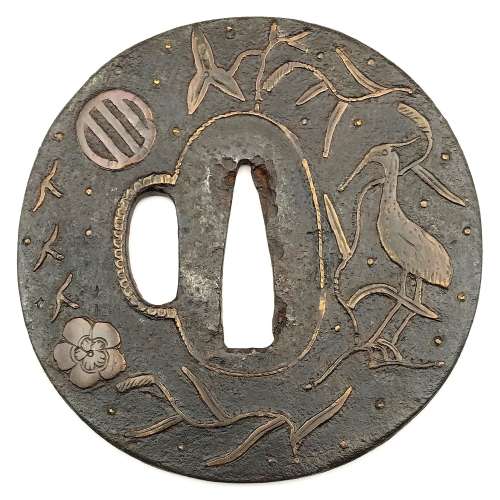 Iron tsuba of round form profusely decorated with brass inlay of plants, birds, well, and family crests (mon) in suemon-zōgan technique and occasional brass dots (nail-heads) or ten-zōgan. Seppa-dai and kozuka-hitsu-ana outlined with brass inaly, possibly repaired: rope-shaped wire here and there replaced with flat wire. The plate is very thin, with remnants of lacquer. Ōnin school. Size: 75.8 x 75.2 x 2.3 mm. Weight: 77.5 g. On the front side (omote) motif includes the following elements (from 12 o'clock, clockwise):
Iron tsuba of round form profusely decorated with brass inlay of plants, birds, well, and family crests (mon) in suemon-zōgan technique and occasional brass dots (nail-heads) or ten-zōgan. Seppa-dai and kozuka-hitsu-ana outlined with brass inaly, possibly repaired: rope-shaped wire here and there replaced with flat wire. The plate is very thin, with remnants of lacquer. Ōnin school. Size: 75.8 x 75.2 x 2.3 mm. Weight: 77.5 g. On the front side (omote) motif includes the following elements (from 12 o'clock, clockwise):- Water plantain (a.k.a. arrowhead, or omodaka): "a perpetual plant of the water plantain family, was also called shōgunsō (victorious army grass). Because of this martial connotation, it was a design favored for the crests of samurai families" [see: Family Crests of Japan. // Stone Bridge Press, Berkeley, CA, 2007; p. 63].
- Heron (sagi): "...considered an emblem of longevity, and from China comes the practice of regarding the bird as a mount of the gods and the Taoist sennin. [...] heron also reflects an inauspicious connotation, for the word sagi is homophone for 'fraud' and 'false pretenses'." [see: Merrily Baird. Symbols of Japan. Thematic motifs in art and design. // Rizzoli international publications, Inc., 2001; p. 112]. Some may say, that this is not a heron but a crane (tsuru). It's very possible, and in this case the negative connotation is lost, but the reference to longevity and allusion to sennin remain.
- Pampas grass (susuki, or obana): as per Merrily Baird, p. 95 and John W. Dower, p. 66, pampas grass is one of the Seven Grasses of Autumn. When combined with flying wild gees, conveys strong autumnal mood.
- Plum blossom (ume): according to Merrily Baird, the flower has a vast variety of symbolic meanings, including longevity, and a reference to the Chinese Taoists. It is used in 80 family crests [see: Japanese Design Motifs: 4,260 Illustrations of Japanese Crests; Compiled by the Matsuya Piece-Goods Store; Translated by Fumie Adachi. // Dover Publications, Inc., 1972.] Plum is "celebrated for its sweet perfume, delicate blossoms, and habit of blooming at the end of winter".
- Tree flying wild geese (kari): "Wild geese arrive in large flocks in southern regions during the autumn months, and following their migratory instincts, head back north in spring" [Family Crests of Japan, pp. 85-86]. "The importance of geese in Japanese art was further secured by stories of several military heroes who had achieved victory in battle when a sudden breaking of ranks by flying geese signaled an ambush. The protective role of the birds led to their frequent use in decorating sword furnishings and possibly also their adoption as a family crest motif.Finally, the goose in Asia plays a role in religious traditions" [Merrily Baird, pp.111-112].
- Hikiryō (line, or bar, or stripe) - a symbol which consists of one, two, or three horizontal or vertical stripes in a circle. "In wartime, Japanese generals [...] surrounded their encampments with huge cloth curtains. Usually these were made of cloth sewn together horizontally and varying in color [...] to distinguish the individual general and his followers. The stripe thus assumed strong martial connotations, and became a mark of identification on personal military gear as well. In the early fourteenth century the heads of the Ashikaga and Nitta, then the two most powerful clans in Japan, both adopted stripe patterns as a family crest". [See: Family Crests of Japan, p. 111 and John W. Dower. The elements of Japanese design - A handbook of family crests, heraldry & symbolism. // Weatherhill, New York, Tokyo, 1985, p. 144].
- Hikiryō, see above.
- Pampas grass (susuki, or obana), see above.
- Bellflower (kikyo): One of the Seven Grasses of Autumn. "As a crest, it have been adopted among the warriors around the thirteenth century, primarily because of it's beauty" [John W. Dower, p. 48].
- Four flying wild geese (kari), see above.
- Weeping willow (yanagi): "It is commonly represented with water, snow, swallows, or herons. A branch of willow (yoshi) is one of the attributes of the Buddhist deity Senju Kannon (Thousand-Armed Kannon), who is said to use the branch to sprinkle the nectar of life contained in a vase. [Merrily Baird, pp. 66-67].
- Lone plum blossom in a well frame/crib (igeta, izitsu): "Well crib was one of the most popular motifs in Japanese heraldry". As a crest it may stay simply for the first character (i) of the family name, however, with a flower inside the well frame, and together with the other symbols present, it may aggravate the sense of autumn-ness. The ten-zōgan dots in this particular case may represent the snowflakes or autumn stars.
-
 Iron tsuba of quatrefoil form with design of bamboo stems and leaves, and a plank bridge in openwork (sukashi). Hitsu-ana of irregular form. Iron with smooth chocolate patina. Copper and shakudō sekigane. This piece is illustrated in Sasano: Japanese Sword Guard Masterpieces from the Sasano Collection, 1994 on page 295 under № 254 with the following description:
Iron tsuba of quatrefoil form with design of bamboo stems and leaves, and a plank bridge in openwork (sukashi). Hitsu-ana of irregular form. Iron with smooth chocolate patina. Copper and shakudō sekigane. This piece is illustrated in Sasano: Japanese Sword Guard Masterpieces from the Sasano Collection, 1994 on page 295 under № 254 with the following description:Nishigaki. First generation Kanshiro (died in the sixth year of Genroku, 1693, at the age of 81). Sukashi design: Bamboo (take). Early Edo period, late 17th century (Kanbun / Enppo era). Height: 72.6 mm; Width: 71.5 mm; Rim thickness: .6 mm; Centre thickness: 5.1 mm. Rounded rim. The shape of this sword guard is a quatrefoil and the design is arranged in the form of a saddle flap. Two bamboo trunks with leaves comprise the design. Calm, soothing and sophisticated are the features of this artist in his later years. Such characteristics may remind one of the work of the first Hikozo.
Provenance: Sasano Masayuki collection, № 254. What is interesting, and what had been found by Bruce Kirkpatrick, is that in the earlier photograph of the same piece ['Sukashi tsuba - bushido no bi' by Sasano Masayuki, photography by Fujimoto Shihara, 1972 (in Japanese), page 245, №201] we clearly see kebori - linear carving that decorates the bamboo leaves and the planks of the bridge. The said kebori have totally disappeared between 1972 and 1994. The tsuba became absolutely flat! Now we can only speculate about the reasons for such cruel treatment of the artistically and historically important item.
Sukashi tsuba - bushido no bi. Author: Sasano Masayuki, photography: Fujimoto Shihara, 1972 (in Japanese). Page 245, №201.
-
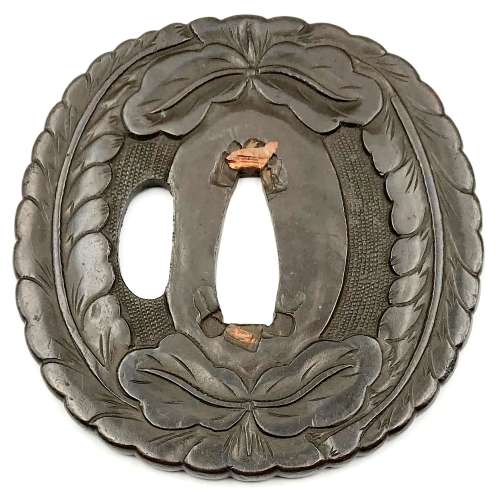 A yamagane (unrefined copper) ko-kinko tsuba of slightly elongated round form with design of wisteria carved in sculptural relief (nikubori). Copper sekigane. Unsigned. Muromachi period, likely the 16th century.
A yamagane (unrefined copper) ko-kinko tsuba of slightly elongated round form with design of wisteria carved in sculptural relief (nikubori). Copper sekigane. Unsigned. Muromachi period, likely the 16th century.Size: 74.3 x 71.8 x 3.2 mm.
NBTHK certificate №4003986: Hozon (worthy preservation). In custom wooden box. -
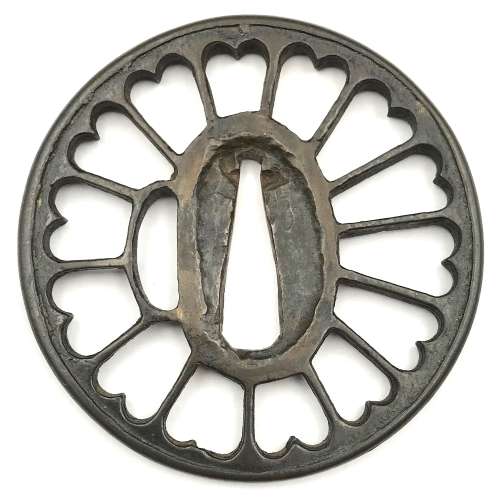 Yamagane tsuba of round form with design of a 14 petal chrysanthemum (kiku) in cast openwork (sukashi), with slightly raised rounded rim. Early Muromachi period (1393-1457). Size: Height: 64.5 mm; Width: 64.0 mm; Thickness at seppa-dai: 4.1 mm; Weight: 52.5 g. Provenance: Sasano collection (though not illustrated in the book 'Sasano: Japanese Sword Guard Masterpieces from the Sasano Collection, 1994', which only covers tsuba made of iron). Wooden box (tomobako) with inscription (hakogaki) by Sasano Masayuki. References: Illustrated on p. 140 at Tosogu: Treasure of the samurai by Graham Gemmell in the article Muromachi period tsuba by Robin Peverett, London, 1991, pp. 131-145. Sold at Sotheby's, London, Thursday 10 April 1997 Sotheby's, London, 1997 [Japanese Swords and Tsuba from the Professor A.Z. Freeman and the Phyllis Sharpe Memorial collections], p. 16: "A ko-kinko bronze Tsuba, early Muromachi period (1393-1453) of circular form, with raised rounded rim, pierced with kiku petals and with a small elongated kozuka-hitsu, the work appearing to be cast and finished by hand. 6.4cm, thickness at centre 4.15mm, at rim 4.8mm. With a Tomobako, bearing a hakogaki by Masayuki Sasano, with rating Shu. Estimated: £1,000-1,500." Hakogaki (courtesy M. Sesko): 古金工 鐔 Ko-Kinkō tsuba 菊花透 無銘 山銅地透 時代 室町前期 古雅入念 秀作 昭和戊辰年伏月 素心鑑 kikka-sukashi, mumei yamagane, ji-sukashi jidai Muromachi-zenki koga nyūnen, shūsaku Showa tsuchinoe-tatsudoshi fukugetsu Soshinkan Kikka-sukashi, unsigned. Of yamagane and with ji-sukashi. Era is early Muromachi period. Excellent and carefully made work of classical elegance. June in the year of the dragon of the Shōwa era (1988) Soshinkan (pen name of Sasano Masayuki).
Yamagane tsuba of round form with design of a 14 petal chrysanthemum (kiku) in cast openwork (sukashi), with slightly raised rounded rim. Early Muromachi period (1393-1457). Size: Height: 64.5 mm; Width: 64.0 mm; Thickness at seppa-dai: 4.1 mm; Weight: 52.5 g. Provenance: Sasano collection (though not illustrated in the book 'Sasano: Japanese Sword Guard Masterpieces from the Sasano Collection, 1994', which only covers tsuba made of iron). Wooden box (tomobako) with inscription (hakogaki) by Sasano Masayuki. References: Illustrated on p. 140 at Tosogu: Treasure of the samurai by Graham Gemmell in the article Muromachi period tsuba by Robin Peverett, London, 1991, pp. 131-145. Sold at Sotheby's, London, Thursday 10 April 1997 Sotheby's, London, 1997 [Japanese Swords and Tsuba from the Professor A.Z. Freeman and the Phyllis Sharpe Memorial collections], p. 16: "A ko-kinko bronze Tsuba, early Muromachi period (1393-1453) of circular form, with raised rounded rim, pierced with kiku petals and with a small elongated kozuka-hitsu, the work appearing to be cast and finished by hand. 6.4cm, thickness at centre 4.15mm, at rim 4.8mm. With a Tomobako, bearing a hakogaki by Masayuki Sasano, with rating Shu. Estimated: £1,000-1,500." Hakogaki (courtesy M. Sesko): 古金工 鐔 Ko-Kinkō tsuba 菊花透 無銘 山銅地透 時代 室町前期 古雅入念 秀作 昭和戊辰年伏月 素心鑑 kikka-sukashi, mumei yamagane, ji-sukashi jidai Muromachi-zenki koga nyūnen, shūsaku Showa tsuchinoe-tatsudoshi fukugetsu Soshinkan Kikka-sukashi, unsigned. Of yamagane and with ji-sukashi. Era is early Muromachi period. Excellent and carefully made work of classical elegance. June in the year of the dragon of the Shōwa era (1988) Soshinkan (pen name of Sasano Masayuki). -
 Artist: Kitagawa Utamaro [喜多川 歌麿] (Japanese, c. 1753 – 1806) "This uncommon half-size horizontal ōban ... is most likely one design from a set of twelve prints issued late in Utamaro's life" [Japanese Erotic Fantasies, Hotei Publishing, 2005, p. 143, pl. 47]. Half-size horizontal ōban must be 12.7 x 38 cm. Richard Waldman and Chris Uhlenbeck say it's tanzaku size (13 x 43 cm). In reality, the prints of this series measure 17 x 38 cm, which corresponds exactly to horizontal o-hosoban paper size. I managed to assemble 11 of allegedly 12 designs. 7 of them have genitals colored by hand. It's hard to tell whether it was done by the publisher on demand of a peculiar buyer, or by the owner of the prints who considered the black and white privy parts unnatural. My sequencing of the prints is arbitrary. Transcription of the text may help find the correct order.
Artist: Kitagawa Utamaro [喜多川 歌麿] (Japanese, c. 1753 – 1806) "This uncommon half-size horizontal ōban ... is most likely one design from a set of twelve prints issued late in Utamaro's life" [Japanese Erotic Fantasies, Hotei Publishing, 2005, p. 143, pl. 47]. Half-size horizontal ōban must be 12.7 x 38 cm. Richard Waldman and Chris Uhlenbeck say it's tanzaku size (13 x 43 cm). In reality, the prints of this series measure 17 x 38 cm, which corresponds exactly to horizontal o-hosoban paper size. I managed to assemble 11 of allegedly 12 designs. 7 of them have genitals colored by hand. It's hard to tell whether it was done by the publisher on demand of a peculiar buyer, or by the owner of the prints who considered the black and white privy parts unnatural. My sequencing of the prints is arbitrary. Transcription of the text may help find the correct order. As Japanese Erotic Fantasies put it: "a couple engaged in love-making, their stare fixed outside the picture plane". This is the only image of series that has a reference in available western literature, and the only one found in museum collections: Rijksmuseum Amsterdam (RP-P-1999-2001-16); reference: Fukuda (ed.) (1990), pls. 11-2.
As Japanese Erotic Fantasies put it: "a couple engaged in love-making, their stare fixed outside the picture plane". This is the only image of series that has a reference in available western literature, and the only one found in museum collections: Rijksmuseum Amsterdam (RP-P-1999-2001-16); reference: Fukuda (ed.) (1990), pls. 11-2.
 The scene of this print looks quite similar to that of the Kiyonaga's Sode no maki:
The scene of this print looks quite similar to that of the Kiyonaga's Sode no maki:
 The woman is "a young lady-in-waiting of Shogun's Court or Daimyō's Mansion, enjoying a rare outing from her tedious chores" [Richard Lane]. She is fully dressed in her outer cloak (shikake), white paper hat (agebōshi or tsunokakushi), and toed socks (tabi). A book or maybe, onkotogami (roll of tissues known as 'paper for honourable act' ) is still in the folds of her kimono. She is holding an open fan, either to cover her and her lover's faces from an unsolicited witness or to bring some fresh air to their joined lips. The pair just started their sexual intercourse.
The woman is "a young lady-in-waiting of Shogun's Court or Daimyō's Mansion, enjoying a rare outing from her tedious chores" [Richard Lane]. She is fully dressed in her outer cloak (shikake), white paper hat (agebōshi or tsunokakushi), and toed socks (tabi). A book or maybe, onkotogami (roll of tissues known as 'paper for honourable act' ) is still in the folds of her kimono. She is holding an open fan, either to cover her and her lover's faces from an unsolicited witness or to bring some fresh air to their joined lips. The pair just started their sexual intercourse.
 A scene from medieval times. A courtier in eboshi cap having sex with an aristocratic young woman with a long straight hairstyle (suihatsu).
A scene from medieval times. A courtier in eboshi cap having sex with an aristocratic young woman with a long straight hairstyle (suihatsu).
 Completely naked couple in the moment of ejaculation. Lavish garments with paulownia leaves on a yellow background counterbalance the white bodies on red bedding. The form of a woman's cheeks is telling, but I don't know about what. Maybe her advanced age?
Completely naked couple in the moment of ejaculation. Lavish garments with paulownia leaves on a yellow background counterbalance the white bodies on red bedding. The form of a woman's cheeks is telling, but I don't know about what. Maybe her advanced age?
 The pose of the couple and the overall composition are similar to that of the previous sheet. Though the lovers are dressed, and the woman's hairdo is well kept. The male looks older and the woman - younger.
The pose of the couple and the overall composition are similar to that of the previous sheet. Though the lovers are dressed, and the woman's hairdo is well kept. The male looks older and the woman - younger.
 A man takes a young maid from behind. She clenches the sleeve of her kimono in her teeth; it's either the moment of penetration (beginning of intercourse) or of her orgasm (the end of it).
A man takes a young maid from behind. She clenches the sleeve of her kimono in her teeth; it's either the moment of penetration (beginning of intercourse) or of her orgasm (the end of it).
 This seems to be a forced intercourse between a lackey with extensive bodily hair and a young maid from the same household.
This seems to be a forced intercourse between a lackey with extensive bodily hair and a young maid from the same household.
 This design is very much like the other one presented below, which is described at Japanese Erotic Fantasies on page 136 (pl. 43b) as follows: "The viewer peers through a mosquito net to see a child fast asleep, while his mother or wet-nurse moves towards her partner. On our print there is no child; instead of a sleeping baby, there is a roll of onkotogami. Fewer objects make the overall image concise, almost laconic in comparison with the Ehon hana fubuki (1802) design:
This design is very much like the other one presented below, which is described at Japanese Erotic Fantasies on page 136 (pl. 43b) as follows: "The viewer peers through a mosquito net to see a child fast asleep, while his mother or wet-nurse moves towards her partner. On our print there is no child; instead of a sleeping baby, there is a roll of onkotogami. Fewer objects make the overall image concise, almost laconic in comparison with the Ehon hana fubuki (1802) design:

 A young couple in a moment of true love. He is listening to the beating of her heart.
A young couple in a moment of true love. He is listening to the beating of her heart.
 This is a moment of true love between an old monk and a young samurai. The latter even did not take of his socks (tabi).
This is a moment of true love between an old monk and a young samurai. The latter even did not take of his socks (tabi).
 From Japanese Erotic Fantasies: "Boats played a crucial role in the workings of Yoshiwara, as they were the primary means of transport to the district. During the hot summer months, trips on pleasure boats were also a favourite pastime. Sex aboard a boat is a recurrent theme in shunga".
The last print that I am currently lacking and hunting for:
From Japanese Erotic Fantasies: "Boats played a crucial role in the workings of Yoshiwara, as they were the primary means of transport to the district. During the hot summer months, trips on pleasure boats were also a favourite pastime. Sex aboard a boat is a recurrent theme in shunga".
The last print that I am currently lacking and hunting for:
 I know where it is, but I cannot reach it... yet.
I know where it is, but I cannot reach it... yet. -
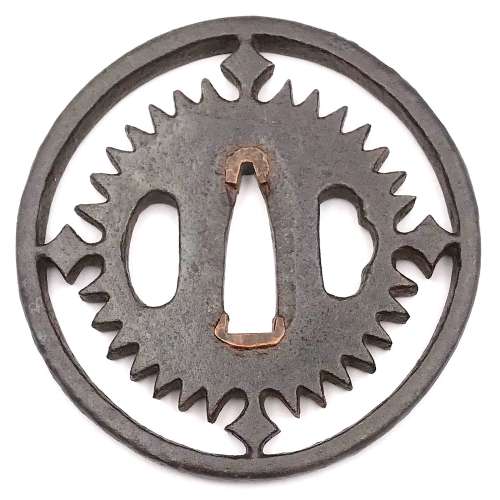 Iron tsuba of round form with design of slanting rays of light (shakoh) or clock gear (tokei) in openwork (sukashi). Commonly considered a Christian / Jesuit motif. Round-cornered rim. Copper sekigane. Momoyama period: Late 16th century (Tensho/Keicho era). Height: 72.5 mm, Width: 72.2 mm, Rim thickness: 5.5 mm, Center thickness: 5.3 mm. Round-cornered rim. Provenance: Sasano collection. Sasano Masayuki, Japanese Sword Guards Masterpieces from The Sasano Collection, Part I, № 136: "The general belief that this design represents the gear of a clock is erroneous, rather it shows the slanting rays of light from a cross, with the small diamond shapes representing the upright and transverse bars. The Christian influence is obvious..."
Iron tsuba of round form with design of slanting rays of light (shakoh) or clock gear (tokei) in openwork (sukashi). Commonly considered a Christian / Jesuit motif. Round-cornered rim. Copper sekigane. Momoyama period: Late 16th century (Tensho/Keicho era). Height: 72.5 mm, Width: 72.2 mm, Rim thickness: 5.5 mm, Center thickness: 5.3 mm. Round-cornered rim. Provenance: Sasano collection. Sasano Masayuki, Japanese Sword Guards Masterpieces from The Sasano Collection, Part I, № 136: "The general belief that this design represents the gear of a clock is erroneous, rather it shows the slanting rays of light from a cross, with the small diamond shapes representing the upright and transverse bars. The Christian influence is obvious..." -
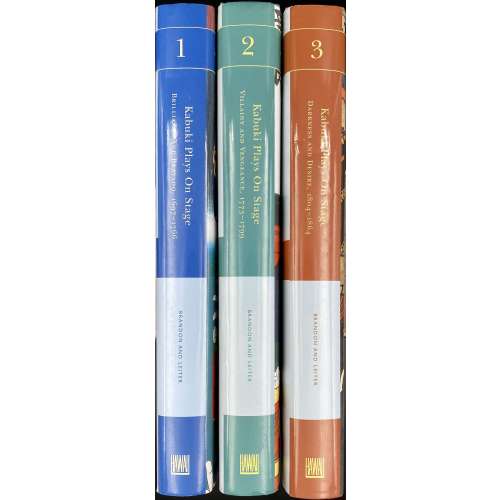 Three volumes, 26.2 x 18.6 cm each: Vol. 1: Kabuki plays on stage: Brilliance and Bravado, 1697-1766; pp.: [i-viii] ix-xiii [xiv blank], 1-391 [1 blank], total 203 leaves, ils. Blue buckram gilt-lettered on spine, pictorial DJ. Vol. 2: Kabuki plays on stage: Villainy and Vengeance, 1773-1799; pp.: [i-viii] ix-xiii [xiv blank], 1-413 [3 blank], total 215 leaves, ils. Green buckram gilt-lettered on spine, pictorial DJ. Vol. 3: Kabuki plays on stage: Darkness and Desire, 1804-1864; pp.: [i-viii] ix-xv [xvi blank], [1] 2-397 [3 blank], total 208 leaves, ils. Ochre buckram gilt-lettered on spine, pictorial DJ. (Vol. 4: Restoration and reform, 1872-1905 – absent for the reason of no interest in the covered period). Contributors: James Rodger Brandon (American, 1927 – 2015) Samuel L. Leiter (American, b. 1940)
Three volumes, 26.2 x 18.6 cm each: Vol. 1: Kabuki plays on stage: Brilliance and Bravado, 1697-1766; pp.: [i-viii] ix-xiii [xiv blank], 1-391 [1 blank], total 203 leaves, ils. Blue buckram gilt-lettered on spine, pictorial DJ. Vol. 2: Kabuki plays on stage: Villainy and Vengeance, 1773-1799; pp.: [i-viii] ix-xiii [xiv blank], 1-413 [3 blank], total 215 leaves, ils. Green buckram gilt-lettered on spine, pictorial DJ. Vol. 3: Kabuki plays on stage: Darkness and Desire, 1804-1864; pp.: [i-viii] ix-xv [xvi blank], [1] 2-397 [3 blank], total 208 leaves, ils. Ochre buckram gilt-lettered on spine, pictorial DJ. (Vol. 4: Restoration and reform, 1872-1905 – absent for the reason of no interest in the covered period). Contributors: James Rodger Brandon (American, 1927 – 2015) Samuel L. Leiter (American, b. 1940) -
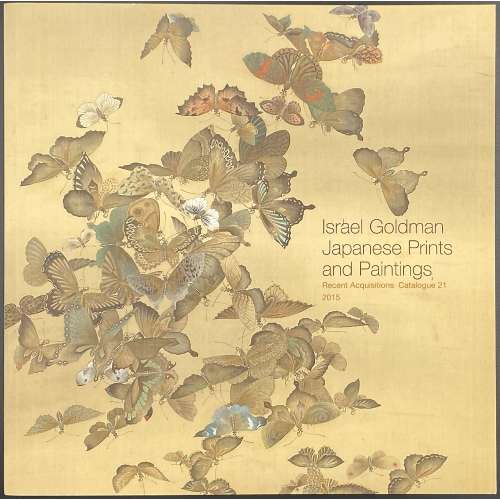 Softcover, pictorial wrappers, square 21 x 21 cm, 40 leaves, unpaginated, with illustrations in colour, 80 entries, with price list laid in; limited edition of 700 copies. Contributor: Israel Goldman In this collection:
Softcover, pictorial wrappers, square 21 x 21 cm, 40 leaves, unpaginated, with illustrations in colour, 80 entries, with price list laid in; limited edition of 700 copies. Contributor: Israel Goldman In this collection: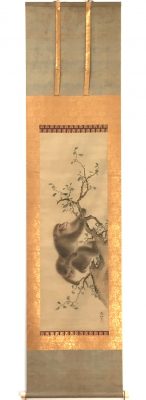
JPD-0008.2016: Mori Sosen. Ink and colour on silk.
-
 Evening Snow on Mount Hira (Hira no bosetsu), from the series Eight Views of Ōmi in Modern Guise (Ryaku Ōmi hakkei, (略近江八景). About 1773–75 (An'ei 2–4). Artist: Isoda Koryūsai (Japanese, 1735–1790) CATALOGUE RAISONNÉ: Hockley 2003, p. 202, #F-21-1 DIMENSIONS: Vertical chûban; 26 x 19.3 cm (10 1/4 x 7 5/8 in.)Signed: Koryû ga [湖竜画]
Evening Snow on Mount Hira (Hira no bosetsu), from the series Eight Views of Ōmi in Modern Guise (Ryaku Ōmi hakkei, (略近江八景). About 1773–75 (An'ei 2–4). Artist: Isoda Koryūsai (Japanese, 1735–1790) CATALOGUE RAISONNÉ: Hockley 2003, p. 202, #F-21-1 DIMENSIONS: Vertical chûban; 26 x 19.3 cm (10 1/4 x 7 5/8 in.)Signed: Koryû ga [湖竜画] -
 Ippitsusai Bunchō [一筆斎文調] (Japanese, 1725 – 1794). Size: Vertical Hosoban. As the Library of Congress put it: "Print shows the actor Ichikawa Monnosuke II, full-length portrait, facing left, standing on the snow-covered veranda". Actor: Ichikawa Monnosuke II [市川門之助] (Japanese, 1743/56 – 1794); other names: Ichikawa Benzō I, Takinaka Hidematsu II, Takinaka Tsuruzō. According to Heroes of the Kabuki Stage [LIB-1197.2016] Ichikawa Monnosuke II was active from 11/1770 to 10/1794. Play: Chūshingura [忠臣蔵] (The Treasury of Loyal Retainers), played at Nakamuraza in the 4the month of Meiwa 8 (1771). The actor played in a variety of roles and performances and was the subject of multiple woodblock prints by many famous ukiyo-e artists, including Bunchō, Katukawa Shunkō, Katukawa Shunshō, Katsukawa Shun'ei, Tōshūsai Sharaku, and many others. Ref: Vever (1976), vol. 1, № 242, p. 227.
Ippitsusai Bunchō [一筆斎文調] (Japanese, 1725 – 1794). Size: Vertical Hosoban. As the Library of Congress put it: "Print shows the actor Ichikawa Monnosuke II, full-length portrait, facing left, standing on the snow-covered veranda". Actor: Ichikawa Monnosuke II [市川門之助] (Japanese, 1743/56 – 1794); other names: Ichikawa Benzō I, Takinaka Hidematsu II, Takinaka Tsuruzō. According to Heroes of the Kabuki Stage [LIB-1197.2016] Ichikawa Monnosuke II was active from 11/1770 to 10/1794. Play: Chūshingura [忠臣蔵] (The Treasury of Loyal Retainers), played at Nakamuraza in the 4the month of Meiwa 8 (1771). The actor played in a variety of roles and performances and was the subject of multiple woodblock prints by many famous ukiyo-e artists, including Bunchō, Katukawa Shunkō, Katukawa Shunshō, Katsukawa Shun'ei, Tōshūsai Sharaku, and many others. Ref: Vever (1976), vol. 1, № 242, p. 227.
Katsukawa Shun'ei. The Actor Ichikawa Monnosuke II in an Aragoto Role. LACME.

Actor Ichikawa Monnosuke II as Date no Yosaku Artist Tôshûsai Sharaku (Japanese, active 1794–1795), Publisher Tsutaya Jûzaburô (Kôshodô) (Japanese) 1794 (Kansei 6), 5th month. MFA.

Ippitsusai Bunchô. Actor Ichikawa Monnosuke II as Tsunewakamaru. Play: Iro Moyô Aoyagi Soga Theater: Nakamura. MFA.
-
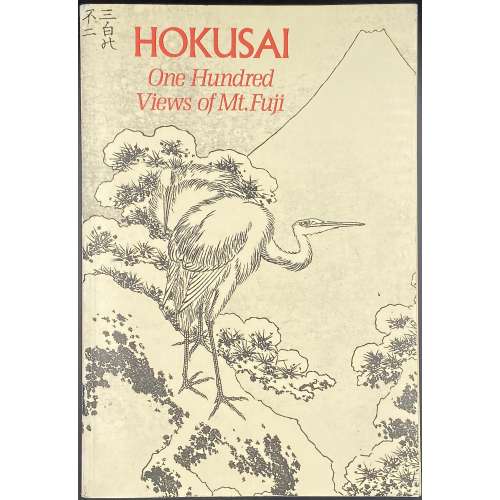 Softcover, 24 x 16.5 cm, publisher's pictorial wrappers, lettering to spine, pp.: [6] 7-224. Full reproduction of Katsushika Hokusai's [葛飾 北斎] (Japanese, 1760 – 1849) series of three illustrated books [絵本, e-hon] One Hundred Views of Mount Fuji [富嶽百景, Fugaku hyakkei], published in Japan in 1834-1849, with commentaries.
Softcover, 24 x 16.5 cm, publisher's pictorial wrappers, lettering to spine, pp.: [6] 7-224. Full reproduction of Katsushika Hokusai's [葛飾 北斎] (Japanese, 1760 – 1849) series of three illustrated books [絵本, e-hon] One Hundred Views of Mount Fuji [富嶽百景, Fugaku hyakkei], published in Japan in 1834-1849, with commentaries. -
![Henri Rollin. L'apocalypse de notre temps / Les dessous de la propagande allemande d'après des documents inédits. — NRF [Nouvelle Revue Française], — Paris: Gallimard, 1939. — Series: Problémes et documents. pp.: [1-9] 10-567 [9].](https://varshavskycollection.com/wp-content/uploads/2021/02/LIB-0371.2015-a-500x500.jpeg) Title: PROBLÈMES ET DOCUMENTS | HENRI ROLLIN | L'APOCALYPSE | DE | NOTRE TEMPS | Les dessous de la propagande allemande | d'après des documents inédits | nrf | S. P. | GALLIMARD | Paris — 43, rue de Beaune Pagination: [1-9] 10-567 [9]. Size: 22.6 x 14.2 cm Binding: original publisher's wrappers. Ex libris Lorenzo Grazzini of Librairie Scritti (book store in Paris). Publishing Year: 1939; Publisher: Gallimard; Acheve d'impremier - Le 23 Septembre 1939 par l'Impremierie Orleanaise 68, rue Royale, Orleans.
Title: PROBLÈMES ET DOCUMENTS | HENRI ROLLIN | L'APOCALYPSE | DE | NOTRE TEMPS | Les dessous de la propagande allemande | d'après des documents inédits | nrf | S. P. | GALLIMARD | Paris — 43, rue de Beaune Pagination: [1-9] 10-567 [9]. Size: 22.6 x 14.2 cm Binding: original publisher's wrappers. Ex libris Lorenzo Grazzini of Librairie Scritti (book store in Paris). Publishing Year: 1939; Publisher: Gallimard; Acheve d'impremier - Le 23 Septembre 1939 par l'Impremierie Orleanaise 68, rue Royale, Orleans. -
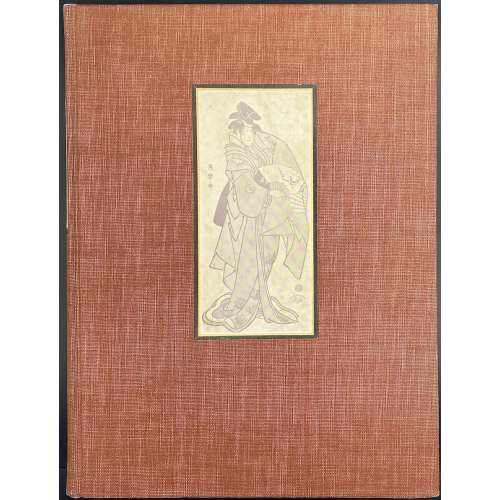 Hardcover volume, 31 x 23.5 cm, bound in full crimson canvas, reproduction colour print with black border pasted to embossed panel, ivory paper label with black lettering to spine, pp.: ffl, [1-4] (t.p./imprint, dedication/blank, 5-337 [338] colophon, 146 b/w woodblock prints by Sharaku photomechanically reproduced, within the pagination. Title-page: THE SURVIVING WORKS OF | SHARAKU | By HAROLD G. HENDERSON | and LOUIS V. LEDOUX | {device} | {blank} | PUBLISHED BY E. WEYNE • NEW YORK | ON BEHALF OF THE | SOCIETY OF THE JAPANESE STUDIES | 1939 || Colophon: PRINTED BY PETER BEILENSON AT THE WALPOLE PRINTING OFFICE | MOUNT VERNON • NEW YORK || Contributors: Harold Gould Henderson (American, 1889 – 1974)– author. Louis Vernon Ledoux (American, 1880 – 1948) – author. Tōshūsai Sharaku [東洲斎 写楽] (Japanese, fl. 1794 – 1795) – artist. Peter Beilenson (American, 1905 – 1962) – printer. Society for Japanese Studies – publisher. Walpole Printing Office (Mount Vernon, NY) – printer
Hardcover volume, 31 x 23.5 cm, bound in full crimson canvas, reproduction colour print with black border pasted to embossed panel, ivory paper label with black lettering to spine, pp.: ffl, [1-4] (t.p./imprint, dedication/blank, 5-337 [338] colophon, 146 b/w woodblock prints by Sharaku photomechanically reproduced, within the pagination. Title-page: THE SURVIVING WORKS OF | SHARAKU | By HAROLD G. HENDERSON | and LOUIS V. LEDOUX | {device} | {blank} | PUBLISHED BY E. WEYNE • NEW YORK | ON BEHALF OF THE | SOCIETY OF THE JAPANESE STUDIES | 1939 || Colophon: PRINTED BY PETER BEILENSON AT THE WALPOLE PRINTING OFFICE | MOUNT VERNON • NEW YORK || Contributors: Harold Gould Henderson (American, 1889 – 1974)– author. Louis Vernon Ledoux (American, 1880 – 1948) – author. Tōshūsai Sharaku [東洲斎 写楽] (Japanese, fl. 1794 – 1795) – artist. Peter Beilenson (American, 1905 – 1962) – printer. Society for Japanese Studies – publisher. Walpole Printing Office (Mount Vernon, NY) – printer -
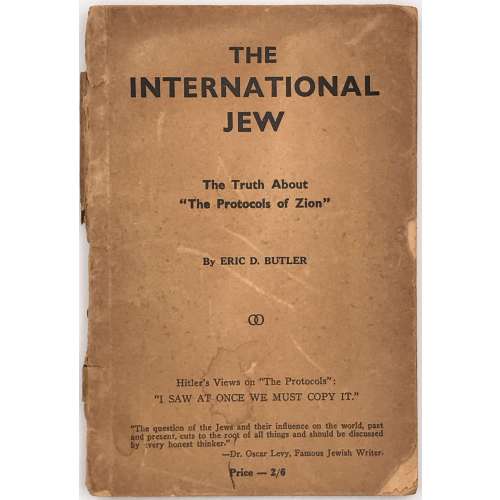 Front wrapper and t.p.: THE | INTERNATIONAL | JEW | The Truth About | "The Protocols of Zion" | By ERIC D. BUTLER | ∞ | Hitler’s Views on “The Protocols”: | “I SAW AT ONCE WE MUST COPY IT.” | “The question of the Jews and their influence on the world, past and present, cuts to the root of all things and should be discussed by every honest thinker” | — Dr. Oscar Levy, Famous Jewish Writer. | Price — 2/6 || (T.p.: same with the full stop (.) after 2/6. Stamp to t.p.: Women’s Voice | 537 SO. DEARBORN ST. | ROOM 800 | CHICAGO 5. ILL. || [2] 3-167 [168]. Binding: Lettered publisher’s wrappers, 18 x 12 cm. Butler, Eric Dudley (Australian, 1916 – 2006) Osborne, Robert Martin (British-Australian, 1862 – 1931) — Australian printer and publisher. Levy, Oscar (German-Jewish, 1867 – 1946) Hitler, Adolf (German, 1889 – 1945)
Front wrapper and t.p.: THE | INTERNATIONAL | JEW | The Truth About | "The Protocols of Zion" | By ERIC D. BUTLER | ∞ | Hitler’s Views on “The Protocols”: | “I SAW AT ONCE WE MUST COPY IT.” | “The question of the Jews and their influence on the world, past and present, cuts to the root of all things and should be discussed by every honest thinker” | — Dr. Oscar Levy, Famous Jewish Writer. | Price — 2/6 || (T.p.: same with the full stop (.) after 2/6. Stamp to t.p.: Women’s Voice | 537 SO. DEARBORN ST. | ROOM 800 | CHICAGO 5. ILL. || [2] 3-167 [168]. Binding: Lettered publisher’s wrappers, 18 x 12 cm. Butler, Eric Dudley (Australian, 1916 – 2006) Osborne, Robert Martin (British-Australian, 1862 – 1931) — Australian printer and publisher. Levy, Oscar (German-Jewish, 1867 – 1946) Hitler, Adolf (German, 1889 – 1945) -
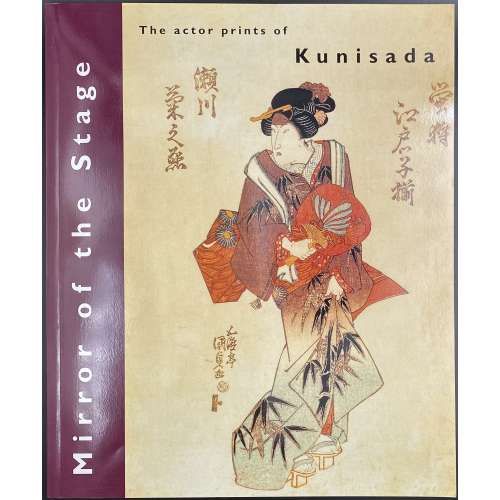 Thin booklet in glossy pictorial wrappers, 29.8 x 24.7 cm, pp.: [1-4] 5-48, 24 leaves total, illustrated. Errata tipped in after the front wrapper. Title-page: Mirror | of the stage | The actor prints of | Kunisada | Ellis Tinios | The University Gallery Leeds || Colophon: Published in March 1996 for the exhibition Mirror of the Stage held at the University Gallery Leeds 24 April-30 May 1996. Introduction: "This book [exhibition catalogue] has been written as an introduction to nineteenth-century Japanese colour woodblock actor prints and to the achievements of the artist Kunisada in that field [as well as to accompany the exhibition of the same name]. It is divided into three sections. In the first, I examine four topics: the social and cultural milieu that gave rise to the production of prints as items of mass consumption; the aesthetic of the actor print; the economics of print production (including consideration of the numbers issued, the prices at which they were sold and their rates of survival); and the process by which prints were produced. The second section consists of sixteen colour plates with commentaries. In the final section, I survey Kunisada's career." Subject: Utagawa, Kunisada, — 1786-1864 — Exhibitions; Ukiyo-e — Exhibitions; Colour prints, Japanese — Edo period, 1600-1868 — Exhibitions. Contributors: Ellis Tinios Utagawa Kunisada [歌川 国貞] a.k.a. Utagawa Toyokuni III [三代歌川豊国] (Japanese, 1786 – 1865). Select illustrations (references in this collection):
Thin booklet in glossy pictorial wrappers, 29.8 x 24.7 cm, pp.: [1-4] 5-48, 24 leaves total, illustrated. Errata tipped in after the front wrapper. Title-page: Mirror | of the stage | The actor prints of | Kunisada | Ellis Tinios | The University Gallery Leeds || Colophon: Published in March 1996 for the exhibition Mirror of the Stage held at the University Gallery Leeds 24 April-30 May 1996. Introduction: "This book [exhibition catalogue] has been written as an introduction to nineteenth-century Japanese colour woodblock actor prints and to the achievements of the artist Kunisada in that field [as well as to accompany the exhibition of the same name]. It is divided into three sections. In the first, I examine four topics: the social and cultural milieu that gave rise to the production of prints as items of mass consumption; the aesthetic of the actor print; the economics of print production (including consideration of the numbers issued, the prices at which they were sold and their rates of survival); and the process by which prints were produced. The second section consists of sixteen colour plates with commentaries. In the final section, I survey Kunisada's career." Subject: Utagawa, Kunisada, — 1786-1864 — Exhibitions; Ukiyo-e — Exhibitions; Colour prints, Japanese — Edo period, 1600-1868 — Exhibitions. Contributors: Ellis Tinios Utagawa Kunisada [歌川 国貞] a.k.a. Utagawa Toyokuni III [三代歌川豊国] (Japanese, 1786 – 1865). Select illustrations (references in this collection):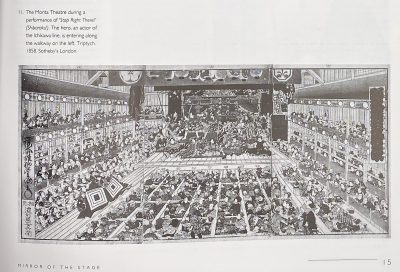
SVJP-0226.2016: Superb Edo pictures illustrating dances, 1858.
-
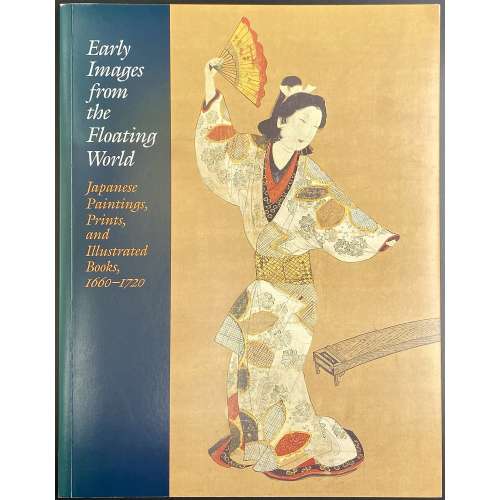 Softcover, in pictorial wrappers, 28 x 21.8 cm, 37 entries, with colour illustrations. Catalogue of the sales exhibition on March 3 - April 5, 2008 in NY; pagination: [1-3] 4-102 [2], ils. Contributor: Sebastian Izzard
Softcover, in pictorial wrappers, 28 x 21.8 cm, 37 entries, with colour illustrations. Catalogue of the sales exhibition on March 3 - April 5, 2008 in NY; pagination: [1-3] 4-102 [2], ils. Contributor: Sebastian Izzard -
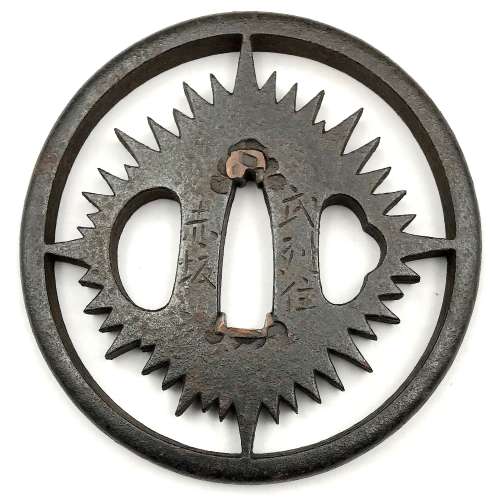 Iron tsuba of round form with slanting rays of light (shakoh) Christian motif (Jesuit’s IHS symbol) in openwork (sukashi). Traditional description of this kind of design is called “tokei”, or “clock gear”. Signed: On the face: Bushu ju Akasaka; On the back: Tadatoki Saku [Made by Tadatoki, resident of Bushu]. Probably, 4th generation of Akasaka School master Tadatoki (忠時), who died in 1746. Akasaka School. Edo period, first half of the 18th century. Size: 79.8 x 78.5 x 6.5 mm
Iron tsuba of round form with slanting rays of light (shakoh) Christian motif (Jesuit’s IHS symbol) in openwork (sukashi). Traditional description of this kind of design is called “tokei”, or “clock gear”. Signed: On the face: Bushu ju Akasaka; On the back: Tadatoki Saku [Made by Tadatoki, resident of Bushu]. Probably, 4th generation of Akasaka School master Tadatoki (忠時), who died in 1746. Akasaka School. Edo period, first half of the 18th century. Size: 79.8 x 78.5 x 6.5 mm


